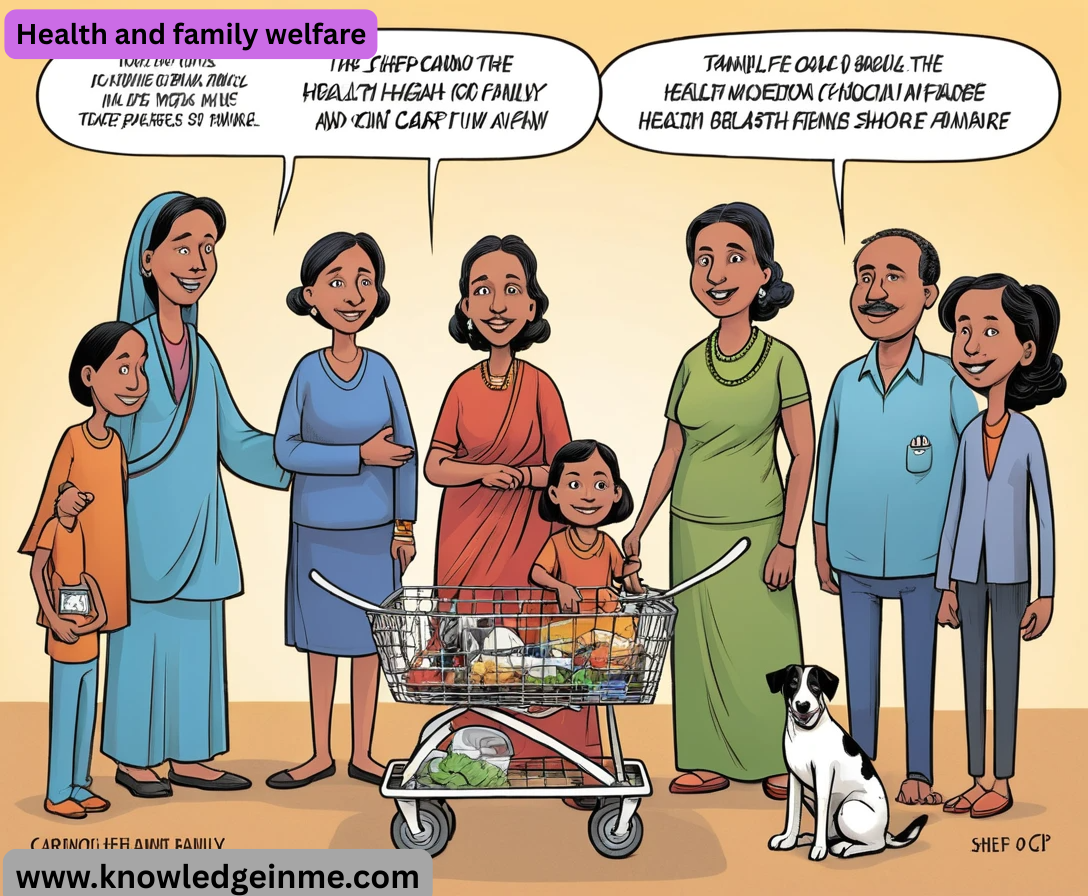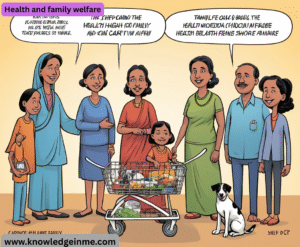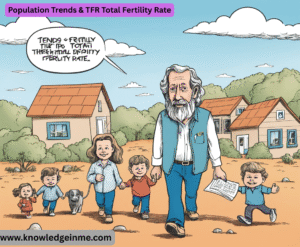Health and family welfare The Ministry of Health and Family Welfare (Mo HFW) is a government body responsible for public health, medical education, and family welfare programs in many countries, particularly in India.
Key Functions of Health and Family Welfare:
Public Health Initiatives
- Disease prevention and control (e.g., immunization, malaria, TB, HIV/AIDS).
- Maternal and child health programs.
- Nutrition programs (e.g., anemia prevention, mid-day meals).
Healthcare Infrastructure
- Strengthening hospitals, clinics, and primary health centers (PHCs).
- Promoting Ayush man Bharat (India’s national health protection scheme).
Family Welfare Programs
- Family planning services (contraceptives, sterilization).
- Reproductive and child health (RCH) programs.
Adolescent health awareness.
Medical Education & Research
- Regulation of medical colleges and nursing institutions.
- Support for medical research (e.g., ICMR in India).
Pandemic & Emergency Response
- Handling outbreaks (e.g., COVID-19, dengue).
- Disaster preparedness and health crisis management.
- Major Schemes (India-Specific Examples)
- Mission Indradhanush – Full immunization coverage for children.
- Janani Suraksha Yojana – Safe motherhood and institutional delivery.
- National Health Mission (NHM) – Strengthening rural and urban healthcare.
Structure of India’s Health System
- Ministry of Health & Family Welfare (MoHFW) oversees:
- Department of Health (Hospitals, disease control, medical education).
- Department of Family Welfare (Family planning, maternal/child health).
Three-Tier Healthcare System:
- Secondary: District Hospitals, Community Health Centers (CHCs).
- Tertiary: AIIMS, PGIMER, and other advanced medical institutes.
Major Challenges in India’s Health Sector
- Urban-Rural Divide: 70% of healthcare facilities in urban areas (but 65% population lives in rural areas).
- High Out-of-Pocket Expenditure: Over 60% of health expenses paid by patients (vs. 18% in the UK).
- Disease Burden: Rising non-communicable diseases (diabetes, heart disease) alongside persistent TB, malaria, dengue.
- Family Planning Gaps: Unmet need for contraception (~10% of married women).
Country HealthModel Life Expectancy Doctor-PatientRatio Govt. HealthSpend (% of GDP)
India Mixed (Public + Private) 70.8 yrs 0.7:1000 ~1.3%
USA Private Insurance-based 77 yrs 2.6:1000 ~17%
UK NHS (Free Universal Care) 81 yrs 2.8:1000 ~8%
China Public Insurance + Private 77 yrs 2.4:1000 ~5.3%
India lags in public health spending (only ~1.3% of GDP vs. WHO’s recommended 5%).
Future Goals (India)
- Universal Health Coverage (UHC) by 2030 (SDG 3).
- Increase health spending to 2.5% of GDP (National Health Policy 2017).
- Digital Health Mission: EHR (Electronic Health Records), telemedicine expansion.
- Eliminate TB by 2025, reduce maternal mortality (currently 97/lakh live births).
Family Welfare Initiatives
- Contraceptive Access: Free condoms, pills, IUCDs (intrauterine devices).
- Sterilization Schemes (Voluntary): NSV (Non-Scalpel Vasectomy) for men, female sterilization.
- Adolescent Health: Rashtriya Kishor Swasthya Karyakram (RKSK) for teen health education.
Health Financing in India
- Public Spending: Only ~1.3% of GDP (vs. global avg. of 6%).
- Private Sector Dominance: 70% of healthcare is private (expensive, unregulated).
Insurance Coverage:
- Ayushman Bharat PM-JAY: Covers 50 crore poor (~40% population).
- ESI (Employees’ State Insurance): For formal sector workers.
- Private Insurance: Only ~15% Indians have health insurance.
Population Trends & TFR Total Fertility Rate
- National TFR: 2.0 (replacement level achieved).
- High TFR States: Bihar (2.9), UP (2.7), Jharkhand (2.4).
- Declining TFR States: Kerala (1.8), Tamil Nadu (1.7).
Best Practices India Can Adopt
- Brazil’s Family Health Program (community health workers reduce maternal deaths).
- Thailand’s Universal Coverage Scheme (achieved UHC with 80% govt. funding).
- Rwanda’s Health Insurance (Mutuelle de Santé) – 90% coverage via low premiums.
Emerging Health Challenges in India (2024 & Beyond)
A. Silent Epidemics
- Mental Health Crisis: 150 million need care, only 7,000 psychiatrists.
- Air Pollution: Linked to 1.6 million deaths/year (lung disease, strokes).
B. Digital Health & AI
- e-Sanjeevani Telemedicine: 10 crore+ consultations since 2020.
- Challenge: Digital divide (only 30% rural India has internet access).
Future Roadmap for India’s Health System
A. Immediate Reforms Needed
- Strengthen PHCs: More doctors, 24/7 services.
- Regulate Private Sector: Cap prices, enforce quality standards.
B. Long-Term Vision (2030 Goals)
- Universal Health Coverage (UHC): Expand PM-JAY to 100% population.
- Eliminate TB by 2025: Faster diagnostics, Nikshay Poshan Yojana (₹500/month for patients).
Special Focus Areas (Pick for More Details)
- Mental Health Policies (Mental Healthcare Act 2017, challenges)
- AYUSH Integration (Can Ayurveda co-exist with modern medicine?)
- Urban vs. Rural Healthcare Divide (Why do cities get 70% of resources?)
- COVID-19’s Lasting Impact (Post-pandemic health system changes)
Constitutional and Governance Framework
Constitutional Provisions:
- Article 47 (DPSP): State’s duty to improve public health
Seventh Schedule:
- Union List (Entry 28): Port quarantine
- Concurrent List (Entry 29): Prevention of diseases
- National Health Policy 2017: Roadmap for universal healthcare
Financial Flows in Healthcare
- Expenditure Analysis (2023-24 Budget):
- Total health budget: ₹89,155 crore (1.3% of GDP)
Breakup:
- NHM: ₹36,785 crore (41%)
- PM-JAY: ₹7,200 crore (8%)
- Medical Education: ₹5,156 crore (6%)
Innovative Financing Models:
- Public-Private Partnerships (PPPs) in district hospitals
- Social Impact Bonds for maternal health
- Corporate CSR funding in tribal healthcare
Top 5 NCDs by DALYs:
- Ischemic Heart Disease (8.7%)
- Chronic Obstructive Pulmonary Disease (5.1%)
- Stroke (4.9%)
- Diabetes (3.2%)
- Mental Health Disorders (2.8%)
Family Welfare – Advanced Analytics
- Contraceptive Prevalence Rate (CPR) Trends:
- All India CPR: 54% (NFHS-5)
State Variations:
- Kerala: 64%
- Bihar: 38%
- Method Mix Analysis:
- Female sterilization: 36%
- Male sterilization: 0.3%
- Modern temporary methods: 13%
Innovative Solutions:
- Mid-level healthcare providers (NHW model)
- Tele-mentoring through ECHO clinics
- Task-shifting to AYUSH practitioners
Digital Health Architecture
- India’s Digital Health Blueprint:
- ABHA (Health ID) – 50 crore+ enrollments
- Health Facility Registry – 1.5 lakh entries
- Electronic Health Records – Interoperability framework
- National Health Analytics Platform – Real-time disease surveillance
Global Health Diplomacy
India’s Global Health Contributions:
- Vaccine Maitri: 290 million doses to 100+ countries
- Telemedicine partnerships with African nations
- WHO Global Centre for Traditional Medicine in Gujarat
Future Scenarios and Projections
Health System Modeling 2030:
- With 2.5% GDP spending:
- UHC service coverage index to improve from 53 to 75
- Out-of-pocket expenditure to reduce from 48% to 30%
Without reforms:
- NCD burden to increase by 25%
- Doctor-patient ratio to worsen to 0.5:1000
Cutting-edge Innovations
Breakthrough Technologies:
- AI-based TB detection (99% accuracy in trials)
- Drone-based vaccine delivery in NE states
- 3D-printed prosthetics at ₹1,000
- Blockchain for drug supply chain integrity
Equity Analysis
Health Disparity Metrics:
- Rural vs Urban:
- ANC coverage: 58% vs 75%
- Institutional deliveries: 72% vs 89%
- Wealth Quintile Gap:
- Stunting prevalence: 12% (richest) vs 42% (poorest)
Climate Change and Health
Projected Impacts:
- Vector-borne diseases to expand by 15-20%
- Heat-related mortality to increase 5-fold
- Nutrition security challenges for 200 million
Political Economy of Health
Policy Implementation Challenges:
- Fiscal federalism issues in health financing
- Private sector regulation dilemmas
- Medical education-industrial complex
- Pharmaceutical lobbying influences




